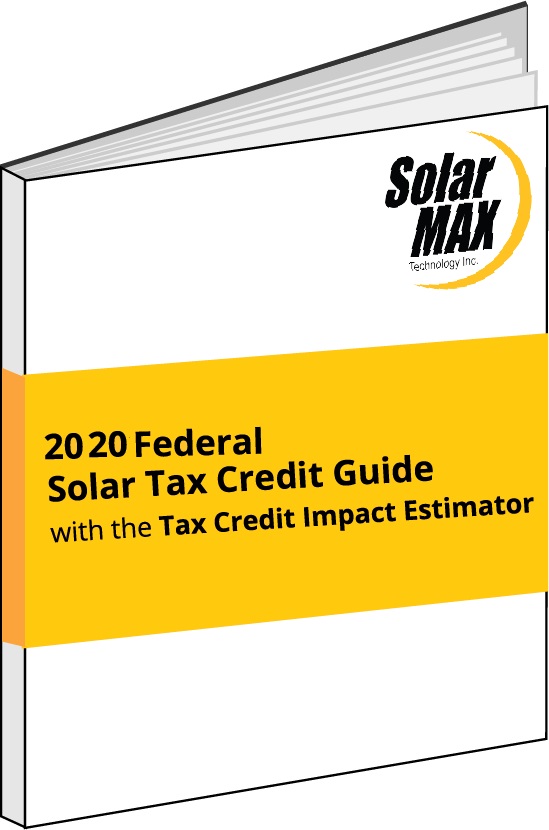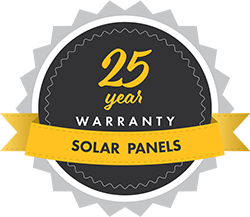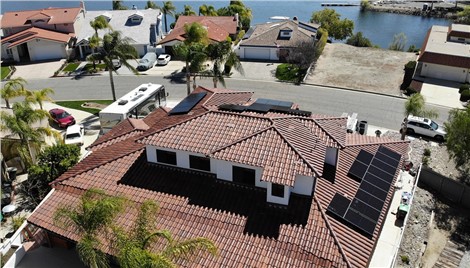There can be a considerable amount of confusion and misunderstanding regarding the Federal Solar Investment Tax Credit. While the concept seems simple, it may be complicated because everyone’s tax situation is different. Since there is no universal answer that applies to all solar owners let’s explore your options.
Disclaimer: Keep in mind that we, at SolarMax Technology, are not tax professionals. We are not qualified to provide homeowners with tax advice. Always seek the advice of a tax professional to determine how to best utilize any federal solar investment tax credit that you may be eligible to receive.
Contents
About the federal solar tax credit
- Eligibility for the solar tax credit
- Residential qualifications
- Business qualifications
- What does the tax credit cover?
- Tax credit rates by year
How to use your tax credit
- What year is my solar tax credit valid for?
- What the solar energy tax credit is NOT:
- What exactly is the federal solar tax credit?
- Is there an easy way to tell how much of the federal solar tax credit I can use?
How to file and claim your tax credit
How to estimate your solar tax credit return for this year
- Is there an easy way to tell how much of the tax credit I can use?
- Download the Federal Solar Tax Credit Guide
- Need further assistance from a qualified renewable energy expert?
About the federal solar tax credit

The federal solar tax credit is a tax credit that you can receive when filing your annual tax return. The tax credit equals 30% of the total cost of your home solar energy system. For example, if your solar energy system costs you a total of $20,000 then you can expect to apply $5,200 in credit to your tax return.
There is no limit to the amount you can claim on this credit. Whether your solar system costs $10,000 or $10,000,000, if you meet the eligibility criteria, you can claim your 30% tax credit on this amount.
Eligibility for the solar tax credit
Before you can claim the federal solar tax credit you need to meet the eligibility requirements like most credits or rebates. The requirements are different depending on whether you are installing solar onto your residence or your business.
Residential qualifications
- Your solar energy system must be providing energy to your home, be approved and in service.
- All local and utility fire and electrical code rules must be met.
- Your system must be installed and operating after January 1, 2006 and on, or before, December 31, 2021.
- You must own your system by purchasing or financing it. A lease or power purchase agreement (PPA) does not qualify you for the tax credit.
Business qualifications
- Your system must be installed and operating after January 1, 2006 and on, or before, December 31, 2021.
- Your solar energy system equipment must be new, not used.
- Your solar energy system must be used by someone that is subject to U.S. income taxes. With the exclusion of tax-exempt organizations like churches, charities or schools.
- Your solar energy system must be located in the United States.
- The electricity produced can’t be used to heat a swimming pool.
What does the Tax Credit cover?
The federal solar tax credit is based on the entire cost of your solar energy system including the costs of:
- The solar panels, inverters and all materials
- All labor installation charges
- Roof repairs necessary to install solar (not the entire roof, just the side(s) that the solar panels are installed on)
- A home battery if it is charged solely by the solar panels
- Any upgrades or home modifications required to be compliant with local code such as main service panel upgrades, trenching, relocation of meters or other appliances.
Tax credit rates by year
As you can see the tax credit goes down in 2022 and 2023 until it expires completely for residential installation in 2024. Businesses can still take advantage of a 10% credit from 2024 and on.
Year | Tax Credit Amount |
2006 to 2019 | 30% |
2020 to 2022 | 26% |
2023 | 22% |
2024 and on | 0% |
How to use your tax credit

What year is my solar tax credit valid for?
The IRS says that you can claim your solar tax credit on the date your system installation is complete and becomes active.
When you get solar installed on your home, an inspector from the utility company comes out for the final inspection and will give you Permission to Operate (PTO). The date you receive PTO is the date your system’s installation is complete and you use this date to determine which year you can begin to claim your solar tax credit in.
Your tax credit can be carried forward to the next year. So if you don’t use 100% the first year, IRS Form 5695 states you can use the remaining balance the next year. However, it is not yet clear whether you can carry an unused solar tax credit to years after the solar credit expires in 2022.
What the solar energy tax credit is NOT:
- It is not a rebate
- It is not a check
- It is not an itemized deduction
What exactly is the federal solar tax credit?
The federal solar tax credit is a credit that can be used to offset your federal income tax liability.
This means that you must owe taxes in order to utilize the tax credit.
- Having a tax liability does not mean that you have to write a check when you submit your tax return. It means that the IRS keeps some of the income tax that was withheld or paid.
- Getting a refund does not mean that you do not owe taxes. It means that more taxes were collected by the IRS than what you ended up owing.
- Not having to write a check to the IRS when you submit your tax return to the IRS does not mean that you do not owe taxes.
The amount of any federal solar tax credit that is used cannot exceed the total tax liability for that year.
- In other words, you cannot use a credit for more than what you owe.
- You may be able to use some of your tax credit now, and some later.
- You may be able to carry over the tax credit to another year and use it when you have a tax liability in a future year.
How to file and claim your federal solar investment tax credit

As mentioned before, the SolarMax Technology staff are not tax professionals. We are not qualified to provide homeowners with tax advice. So always seek the advice of a tax professional to determine how to best utilize any federal solar tax credit that you may be eligible to receive.
The IRS provides instructions for filling out Form 5695 required for claiming the tax credit: 2018 Instructions for Form 5695
How to complete Form 5695
IRS Form 5695 calculates tax credits for a variety of residential energy improvements including solar. You only need to focus on line 1 which is for solar electricity.
- Line 1: Start by putting the total of all your solar energy system costs into line 1.
- Line 5: Add lines 1 through 4 and put the total into line 5.
- Line 6: Multiply line 5 by 26% (.26) and enter the number into line 6.
The amount in Line 6 is your tax credit.
Example: Using a total system cost of $20,000
1 | Qualified solar electric property costs | 1 |
|
2 | Qualified solar water heating property costs | 2 | 0 |
3 | Qualified small wind energy heating property costs | 3 | 0 |
4 | Qualified geothermal heat pump property costs | 4 | 0 |
5 | Add lines 1 through 4 | 5 | $ 20,000 |
6 | Multiply line 5 by 26% (.26) | 6 | $ 5,200 |
How to estimate your solar tax credit return for this year
Is there an easy way to tell how much of the tax credit I can use?
No. The easiest way is to consult your tax professional. However, SolarMax Technology has developed the Tax Credit Impact Estimator to help customers understand how the tax credit may affect them by showing how it might have affected their taxes in the previous year.
If your taxes in the year of installation are going to be the same as last year, then you may get a good idea how the tax credit affects you for this year.
Give SolarMax Technology a call or fill out the request form to get started today.
Your eBook "Federal Solar Investment Tax Credit: A Practical Guide" is available for download:
Contents:
- About the federal solar tax credit
- What does the tax credit cover?
- How to use your tax credit
- How to file and claim your tax credit
- Bonus material: the Tax Credit Impact Estimator





